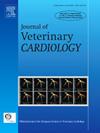Assessment of heart rate measurements obtained from a smart collar compared to 24-h Holter monitoring in healthy dogs
IF 1.3
2区 农林科学
Q2 VETERINARY SCIENCES
引用次数: 0
Abstract
Introduction/Objectives
The primary objective was to compare the 24-h mean heart rate (HR) provided by a smart collar with 24-h ambulatory electrocardiography (Holter) in healthy dogs. The secondary objective was to compare the 2-min HR values between the two methods during periods of activity and rest.
Animals, materials, and methods
Twelve healthy dogs were fitted with both Holter monitors and smart collars. Passing-Bablok regression and Bland-Altman (BA) agreement analysis were used to compare the 24-h mean HR between two methods. The BA analysis for repeated measures and bias plots were used to compare 2-min HR between methods.
Results
The regression analysis showed no significant differential or proportional bias between the methods to estimate 24-h mean HR. The BA analysis showed a mean bias of 2.2 beats per minute (bpm) (95% confidence interval = −0.2, 4.8) with an upper limit of agreement (LOA) of 9.6 bpm (5.1, 14.1) and a lower LOA of −5.1 bpm (−9.5 to −0.6). However, BA analysis of 2-min HR showed poor agreement between methods with wide LOAs at rest and during activity. The smart collar did not provide any HR information for 43% of the total possible recording duration (range = 24%–79%).
Study Limitations and Conclusions
The smart collar can provide a potentially clinically useful estimate of 24-h HR in dogs with normal sinus rhythm. The collar did not provide reliable 2-min HR measurements due to inaccuracies in HR estimation during periods of activity and the inability to report any HR during large periods of the recording.
将智能项圈获得的心率测量值与健康犬的 24 小时 Holter 监测值进行比较评估。
简介/目标:主要目的是比较智能项圈提供的健康犬 24 小时平均心率(HR)与 24 小时动态心电图(Holter)。次要目标是比较两种方法在活动和休息期间的 2 分钟心率值:12 只健康狗同时安装了 Holter 监测器和智能项圈。使用 Passing-Bablok 回归和 Bland-Altman (BA) 一致性分析比较两种方法的 24 小时平均心率。重复测量的 BA 分析和偏差图用于比较两种方法的 2 分钟心率:结果:回归分析表明,在估算 24 小时平均心率时,两种方法之间没有明显的差异或比例偏差。BA分析显示平均偏差为每分钟2.2次(bpm)(95%置信区间=-0.2,4.8),一致性上限(LOA)为每分钟9.6次(5.1,14.1),LOA下限为每分钟-5.1次(-9.5至-0.6)。然而,对 2 分钟心率的 BA 分析表明,不同方法之间的一致性较差,休息和活动时的 LOA 较大。在可能的总记录时间中,智能项圈有 43% 的时间没有提供任何心率信息(范围 = 24%-79%):研究局限性和结论:智能项圈可为窦性心律正常的狗提供临床上有用的 24 小时心率估计值。由于在活动期间心率估算不准确,以及在大段记录期间无法报告任何心率,项圈无法提供可靠的 2 分钟心率测量值。
本文章由计算机程序翻译,如有差异,请以英文原文为准。
求助全文
约1分钟内获得全文
求助全文
来源期刊

Journal of Veterinary Cardiology
VETERINARY SCIENCES-
CiteScore
2.50
自引率
25.00%
发文量
66
审稿时长
154 days
期刊介绍:
The mission of the Journal of Veterinary Cardiology is to publish peer-reviewed reports of the highest quality that promote greater understanding of cardiovascular disease, and enhance the health and well being of animals and humans. The Journal of Veterinary Cardiology publishes original contributions involving research and clinical practice that include prospective and retrospective studies, clinical trials, epidemiology, observational studies, and advances in applied and basic research.
The Journal invites submission of original manuscripts. Specific content areas of interest include heart failure, arrhythmias, congenital heart disease, cardiovascular medicine, surgery, hypertension, health outcomes research, diagnostic imaging, interventional techniques, genetics, molecular cardiology, and cardiovascular pathology, pharmacology, and toxicology.
 求助内容:
求助内容: 应助结果提醒方式:
应助结果提醒方式:


